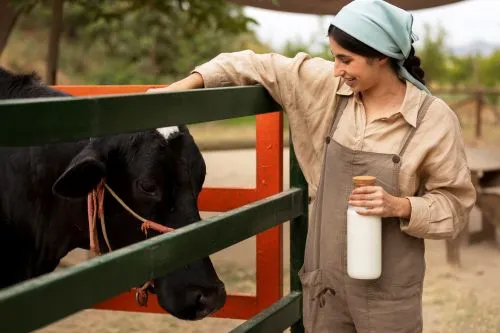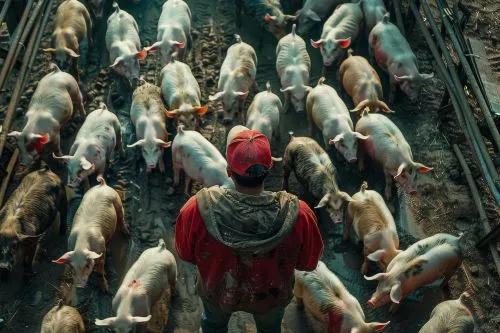
At the beginning of this year, there were two reports of clinical outbreaks of facial eczema in the Australian Gippsland region. As a result, experts expect the prevalence of facial eczema to increase in the future, as global warming provides suitable conditions for widespread outbreaks of the disease over longer periods. But what are the consequences?
Harmful Effects of Sporidesmin
According to DairyGlobal, Hans van Wees, a farmer from Maffra Gippsland, Victoria, witnessed the effects of the disease, prompting him to say, "If you love agriculture, the aspect of facial eczema is awful," he says. Hans started dairy farming in 2008. "It's a seasonal dairy farm," he explains. The cows calve once a year. He milks 880 cows, grazed on 200 hectares. Last year he produced 415,000 kilograms of milk solids with 840 cows. This year he aims to produce 435,000-440,000 kg of milk solids. He supplies milk to Fonterra.
Hans emigrated from the Netherlands to New Zealand in 1979. He initially studied agricultural sciences at Massey University in Auckland. After working as a sharemilker for over 10 years, he moved to Australia. Hans worked on two other farms before eventually having his own farm near Maffra, about 30 kilometers from Sale in Central Gippsland.
Until now, there haven't been issues. Outbreaks of facial eczema have been reported in the past in the state of Victoria. But now, it has mainly been seen in the eastern part of the Gippsland region. Facial eczema is caused by the toxin sporidesmin, which is produced by the spores of the fungus Pithomyces chartarum. The fungus grows in dead bedding, at the base of pasture, and prefers warm, wet conditions.
When ingested by cattle, sporidesmin damages the liver and bile ducts. The affected liver cannot rid the body of waste, and a breakdown product of chlorophyll accumulates in the blood, causing sensitivity to sunlight, which in turn leads to skin inflammation.
Zinc, a Protector Against Facial Eczema
Zinc acts as a protector against facial eczema. Dairy Australia explains that zinc prevents cell damage by forming an inactive complex with sporidesmin. It also inhibits the intestinal absorption of copper, which catalyzes the formation of oxygen-free radicals that cause cell damage. Therefore, zinc supplements can be effective for controlling and preventing facial eczema.
The number of spores on sentinel farms in different areas starts with the warm period of each year. If the spore count increases to dangerous levels, authorities issue an alert to dairy farmers in the affected regions to monitor their own spore counts on pasture and begin supplementing their milking herds with zinc oxide.
Hans van Wees was one of the contributors to the report "A Review of Facial Eczema," which is being cited in this article. He first experienced the effects of facial eczema in New Zealand, where he was working at a cooperative at the time. "In New Zealand, they also have a monitoring system. They monitor the spore count and warn you when to use zinc oxide to prevent the disease's effects," he says. However, the system didn't fully protect the farm's cattle. "In one year, we had 3 or 4 cows with facial eczema," he says. "Their teeth were sunburned, and some skin fell off. So, it was quite bad. Prevention is the best option, of course."
Calves Suffered Liver Damage
When Hans arrived in Australia, farmers weren't particularly concerned about facial eczema, he recalls. "They didn't see it here back then. Over the years, we've had a lot of spores, but we never had issues with our dairy cows because of the use of zinc oxide. We had an issue with about 15 calves getting facial eczema. It was impossible to get rid of the toxin, so we minimized grass intake. We increased the supplement intake and found pastures with low spore counts."
But the calves with facial eczema ended up having liver damage and sunburn marks on their skin. "They recovered, but they seemed more predisposed to other problems about a year later. Their liver was compromised. After that, they did better," says Hans.
He emphasizes that farmers often give their cattle zinc boluses, one per animal. The boluses release a consistent amount of zinc oxide to protect the animals from facial eczema for up to four weeks. "But we can't use them in Australia," says Hans. "They haven't been approved by the Australian Veterinary Association, and there are not many countries where they are authorized."
Monitoring Spore Count
Hans explains that monitoring the spore count and weather conditions is a crucial tool for predicting periods of toxicity. "Usually, we get a warning if the spore count is at a dangerous level. Then, you can take action. We feed a zinc bolus. We've done that for up to 120 days. In the last few years, there has been a high spore count every second year, typically at the end of summer, beginning of autumn."
After 100 days of zinc bolus feeding, the cows need to be tested. "We take blood samples and check zinc levels, so we don't get to toxic levels," says Hans. "Farmers need to be very careful and do the calculations right. It's important to make sure the actual dosage needs to be in the feed. There are no shortcuts."
Critical Dosage
Hans says there have been too many stories of things going wrong. "Farmers can give too little or too much. If you overdose, you get very sick cows. If you don't give enough, it doesn't work. There's a critical dosage that the cows need, and you need to get it right to make it work. You have to do it properly. Otherwise, there could be effects for an entire generation of young calves or young cows. Zinc isn't expensive for farmers," says Hans. But the damages caused by facial eczema are terrible. They lose their skin, they don't eat, some of the animals die. "I've seen it, and it's a nightmare, I can't bear to watch." That's why Hans is extremely vigilant in protecting his animals, keeping a close eye on the spore count.
According to the analysis conducted by Dairy Australia, the prevalence of facial eczema in New Zealand and in Gippsland, as well as other dairy regions in southern Australia and the world, may increase in the coming years, as the effects of global warming can provide suitable conditions for more widespread outbreaks of the disease over longer periods.




